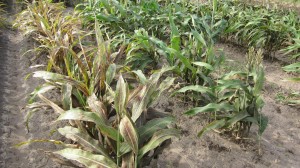As noted in previous years, Texas A&M AgriLife’s Crop Testing Program (http://varietytesting.tamu.edu) annually conducts fee-based hybrid performance tests across Texas. These replicated tests also report multi-year data for up to three years at most locations. Visit the above website and click on ‘Grain Sorghum’ to learn about trials in your region. Results for 2014 to date include (“*”, 3-year data now or soon available): Monte Alto (full* & limited* irrigation), Gregory*, Thrall*, College Station*, Hondo*, Danevang*, Farmersville*, and Hill County. Results are forthcoming from High Plains irrigated (Lubbock, Hereford, Perryton) and dryland (Lubbock, Lamesa, Perryton, Clovis NM) locations.
What about seed company grain sorghum hybrid trials?
Numerous companies have in-house tests which focus primarily on their own hybrids but often include a few competitor’s hybrids. Though these trials are not considered ‘independent’ in the sense that a farmer or researcher would desire, these trials have an important role in identifying performance leaders within an individual company’s hybrid selections, especially as new hybrids are released that must be compared to the company’s old favorites.
Are there commercial hybrids with resistance to sugarcane aphid?
This is being investigated by several researchers including entomologist Dr. Scott Armstrong, USDA-ARS, Stillwater, OK. Texas A&M AgriLife grain sorghum breeders released sugarcane aphid resistant line TX-2783 in the early 1980s, and this line is apparently in the background of several commercial grain sorghum hybrids. It remains to be seen if this commutes effective resistance to any current commercial hybrid though there are early indications that it does based on greenhouse testing and some early field observations (Fig. 1). However, it has not been publicly discussed yet which commercial hybrids are potentially resistant. These hybrids may or may not otherwise be good performing hybrids for yield so we cannot assume at this time that a farmer would want to automatically plant a potentially resistant hybrid if they might be sacrificing significant yield potential.









